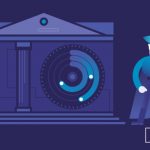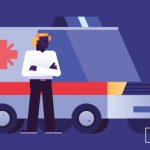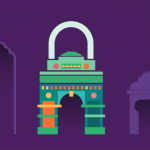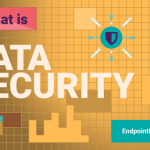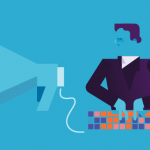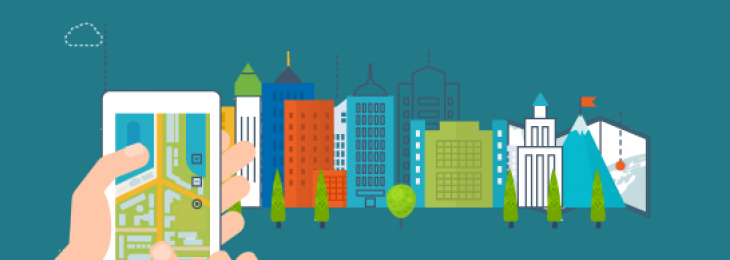
With actual real-life successful implementations in many industries, we have to stop talking about the Internet of Things as an innovation of the future, a next generation technology. IoT is already here, it is changing our lives every day without even noticing and, in no time, we will not be able to imagine life without it. And if you are concerned that your refrigerator might know your dietary habits better than you, do not stress about it. Sooner or later you will come to peace with it.
Currently, Internet of Things (IoT) can be divided into five niche markets: smart cities, connected cars or smart transportation, smart homes, industrial internet, and wearables.
In the next few examples, we will see how IoT is currently used, what value it brings to many existing systems and how will it evolve, as well as what risks it presents.
1. Smart cities
One of the challenges IoT addresses is sustainable urban development. The rapid expansion of urban areas from multiple perspectives – demographic, economic, architecture, etc. has started to put pressure on the environment and on the quality of life due to pollution, stress (caused by heavy traffic and over-populated areas). With the emerge of the Internet of Things, a new approach has risen and it promises to solve many of the current problems.
Juniper Research put together a ranking of the world’s smartest cities, according to multiple factors (approximately 40) such as intelligent lighting, intelligent traffic monitoring and optimization, smart parking, and others. Singapore was named ‘Global Smart City’ in 2016, with the best and most advanced implementation of IoT, as well as vision and strategy for the future. Currently, in Singapore there are sensors that can let authorities know when people are smoking in prohibited are when they are littering from tall buildings, and if the buses have too bumpy rides, indicating the roads need maintenance.
Barcelona is not just one of the most beautiful cities in the world, through its famous architecture, but also one of the smartest. It uses smart parking sensors, smart streetlights, sensors capable of capturing data about noise, pollution, traffic, crowds, smart LED lighting, and many others which are publicly described on the city hall website.
London, the third world smartest city, has gained this position for its smart traffic monitoring and diminishing of traffic congestion, which is currently costing London’s economy £2 billion due to the 70 hours per year people waste in traffic, using more than 600 sensor points. (source: https://www.london.gov.uk)
2. Smart transportation
The world we see in SF movies is becoming reality. Many of us dreamed at red sports talking car, like Hasselhoff’s Knight Rider, but we had no clue this could become reality any time soon. Cars are getting smarter because of the advanced on-board technology, navigation tools, and app integration. They can reduce traffic, avoid accidents, and improve transportation efficiency.
The number of smart cars, self-driving cars, controlled through Wi-Fi, and smartphones are visibly increasing, offering drivers easier and safer ways to travel through their advanced features like adaptive cruise control, voice command, anti-sleep measures, emergency response sensors, parking sensors, etc. Drivers can now connect their smartphones to their cards to access information apps.
Even if one of the main smart cars’ objectives is to reduce the number of accidents on the road, the recent cases of Tesla’s incidents remind us that it’s not enough to completely rely on autonomous technology. Tesla’s autopilot system failed when trying to differentiate a white tractor-trailer crossing the highway against the bright sky. It didn’t use the breaks to avoid it resulting in the death of its driver. Besides safety tools, drivers need to be alert and attentive to take full advantage of the technology and benefit of the safest mode of transportation.
Internet of Things (IoT) technology is used today in public transportation as well. Passengers get various benefits from the smart connected public transportation systems: they can buy digital transportation tickets, have access to the internet via a WiFi network on the vehicle, can use specific apps for travel information, etc. Real time tracking, information about traffic and route conditions through cameras and sensors can be offered today in order to improve traffic efficiency. Mobility services like Uber, shared bikes, etc. contribute to today’s evolution of transportation.
3. Smart Homes
Smart home technology is booming and the number of connected household devices are increasing – smart security systems, stoves, TVs, refrigerators, etc., all being remotely controlled by a smartphone, tablet or computer. IT giants and startups collaborate to develop smart devices for smart homes. The most used smart home products are produced by Google, Apple, Microsoft, and Samsung.
According to Strategy Analytics, around 224 million homes will have at least one type of a smart home system, by 2019. Gartner predicts that smart homes will have over 1 billion connected things in 2018.
The possibilities are endless in a smart home: you can tell your thermostat to change the temperature, track your pet with your mobile, send voice commands to a smart speaker to tell you the weather or read you the news, get alerts when your windows or doors are left opened, etc., and all from a single device: smartphone, tablet or computer.
4. Healthcare
Hospitals and patients benefit from the use of healthcare IoT, the most popular being mobile medical apps or wearables that store patients’ health data like vital signs, EKG stats, etc.
Thermometers, electrocardiograms, ultrasounds and others are now Internet-connected, giving patients the opportunity to track their health. With the help of home monitoring systems, patients and doctors are able to keep track of a person’s health, out of the doctor’s office, especially in the case of elder people. Elder care is a big niche market for the healthcare IoT. For example, Wellness offers family members of elder patients the possibility of tracking and monitoring them, learning their daily activities and identifying anomalies that may represent a problem. Automated temperature, light and security settings in their homes can be also set.
The security risks downside
IoT is here to stay, from fitness, health monitoring, driving, working or cooking and will continue to grow massively, as all industries seek to improve their technology and efficiency. The smart devices and sensors changed the way we work and live, but its positive impact also brought security threats.For example, external attackers represent a big privacy threat for smart homeowners; they can remotely gain access and control the internet-connected devices, like cameras used for security, baby monitoring, etc. Smart cars can be hacked and taken over by cyber criminals, just like in the Jeep Cherokee’s case, where cyber criminals remotely hacked into the car and paralyzed it.
Strong security measures are needed to protect our data and privacy, by adding a multi-layer security solution. An ideal IoT security solution for internet connected devices must secure stored data, the communication between them, and protect them from cyber-criminals.
IoT security is widely understood and accepted, but the hard part intervenes in the implementation. It is both a challenge and an opportunity for developers and vendors, taking into consideration the multiple protocols designed specifically for the Internet of Things, like the Constrained Application Protocol (CoAP). A simple solution and many times ignored is tokenization. Tokens are used for many types of data like payment details, medical records, stock trades and other personally identifiable information. In IoT it could be the way to secure the end-to-end communications, replacing transmitted sensitive data with unique id symbols. The bilateral communication between devices, sensors, and servers or apps cannot be intercepted if tokenization is used and threats like devices hijacking or DoS attacks are prevented.
It is time to assess, adapt, and apply the best security measures that would propel IoT to a higher level in the innovation space.
Download our free ebook on
Data Loss Prevention Best Practices
Helping IT Managers, IT Administrators and data security staff understand the concept and purpose of DLP and how to easily implement it.

